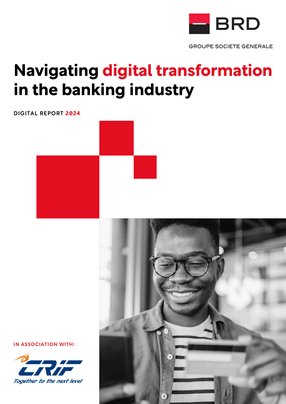Navigating digital transformation in the banking industry
The banking industry has witnessed steady growth since its inception and in the evolution of its banking practices over the years. Before the introduction of technology, individuals had to endure lengthy queues at banks to access their funds or fill in multiple documents by hand, whereas today, the convenience of payment cards and online banking services enables a huge range of seamless transactions.
The ongoing advancement of technology has brought about a number of significant transformations in banking methods. Over the past decade, the banking sector has undergone some major changes, primarily driven by the effects of digitisation. The digital revolution has not only reshaped how customers engage with their banks but has also redefined the operational landscape of financial institutions.
Digital transformation is a top priority for some banks, as it can make banking processes easier and more convenient for customers, leading to an overall higher customer satisfaction. BRD, a Romanian-based bank founded in 1923, is one such institute that is focused on digital transformation for that reason.
“The ultimate vision for BRD is definitely to operate as a customer-centric, universal operational model,” says Maja Mikic, Executive Director for Digital Transformation. “And top offers a rich span of top quality financial services to justify the symbol of Société Générale because this is how it is perceived across Europe and to make ourselves, in two years from now, the leader in the digital banking offer as well.”
Growth and commitment to going beyond traditional financial services
Throughout the years, BRD has focused its efforts on catering to a wide-ranging customer base, extending its reach through a comprehensive network of over 500 branches and a devoted team of over 6,600 employees. Its extensive range of products and services extends beyond traditional financing, encompassing cash management, both internal and external factoring, as well as financial and operational leasing.
“BRD is a bank which spread its wings after the Romanian revolution in 1989, and has been operating as a bank for the Romanian development; this is what the acronym stands for. Then in about 2000, it was purchased by the French giant, Groupe Société Générale, which counts as one of Europe’s top-tier banks.” explains Mikic.
Mikic, who graduated in Theoretical Maths and afterwards mastered Financial Engineering, has been with the Groupe Société Générale for 18 years, starting her career in IT as an Information Technology Developer.
“One of the options after graduation was to work in the IT department of a bank on changing the central banking system, where the need for young engineers was quite high. I then pursued a job in finance because financial pirating was really important during those years; we’re talking about 2008/2009, and the profitability steering started to be very quantitative.”
From risk management to digital transformation
Mikic’s early working life primarily centred around her mathematical expertise within the banking sector. Her role involved assessing profitability, cost distribution, fund transfer pricing, and similar financial aspects. Over time, this role evolved to align with the ever-changing financial landscape, adapting to shifts and crises in Central Eastern Europe.
While the 2008 financial crisis did not directly impact Mikic’s region, its effects were delayed and ultimately came to light around 2012. This was when credit risk issues became particularly pronounced and Mikic found herself undertaking missions that took her from one country to another, focusing on enhancing and managing asset quality. Her journey spanned from the Czech Republic to various countries in the region, including Bulgaria, and Moldova, before ultimately landing in Romania.
“About eight years ago, the word ‘crisis’ had redefined the meaning when it came to credit risk,” Mikic explains. “When this was resolved and the risk management job became quite boring, they moved me to digital transformation because the bank hadn’t invested a lot of time in the resources to follow the digitalisation trends.
“So, in the last three years, I've been in charge of all projects which have the main goal of digitising the banking offer, bank on distance, remote banking, digital banking, and all the digital safe channels. But also, the downsizing of the physical distribution network, meaning the branches and digitalising processes within them, in order to downsize and optimise the operating expense.”
The dawn of digital transformation
The adoption of digitisation has enabled banks to harness the potential of data analytics and AI in order to enhance their decision-making processes and provide a more personalised service to clients. Through the collection and analysis of customer data, banks can customise their offerings to align precisely with the unique requirements of each individual customer.
In order to better serve its customer base, all of Société Générale’s businesses are continuously working to ramp up their digital transformation, in particular by adopting data processing and AI technologies.
“AI is being introduced on a small scale, meaning we have a very consistent path ahead, which is the way to go with AI,” explains Mikic. “We first of all started by introducing some RPAs for tasks that were the least provoking or stimulating – basically, we eliminated the boring stuff, if you want.
“Then afterwards, we started using the data analytics that was accessible from the banking experience, and machine learning in order to eliminate potential threats and boost the good clients ahead in a seamless experience.”
Over the years and under Mikic’s leadership, BRD has utilised customer profiles to predict client behaviour, as well as monitor those who express dissatisfaction or desire to leave the bank, referred to in the industry as a churn model. This allows BRD to work towards fulfilling its overall vision of ‘operating as a customer-centric, universal model’, by offering the highest level of customer service, while simultaneously complementing the company’s digital banking efforts.
Safeguarding businesses in a digital world
The advancement of AI has brought with it a wide array of advantages to a number of industries. Over the past decade, the significant rise in the increase of AI adoption and machine learning (ML), has empowered organisations to successfully leverage these technologies, integrating them into their business practices. However, as with any new technology, there are associated risks that come with the territory.
“Entire risk management is crucial,” Mikic explains. “At BRD we don’t just do it occasionally or once a problem arises, we do it consistently. There are a lot of ill intentions in the market, a lot of trust-abusing phishing attacks and there is no bulletproof system, we know that.
“Fortunately, we have a cybersecurity team who are up-to-date with every single feature that is going on and that we are planning to implement. This is the only way to be able to put the threat and mitigation in the proper context.”
A collaborative future in digital transformation
It is predicted that the next steps for BRD’s digital transformation process will involve using large language models (LLMs) for improved customer interaction, as well as assisting the company’s internal staff in navigating regulations and customer inquiries.
“We are going to take advantage of LLMs which will be in the narrative between the website and the customer, and we will use similar LLMs to help our internal staff go through legislation – the internal normative – as well as frequently asked questions and how to deal with the customer,” explains Mikic.
Over the next year, BRD will pay close attention to its online mortgage loan product, collaborating with global FinTech company, CRIF, to make the entire process more streamlined and efficient for customers.
Mikic says: “For many customers, a mortgage loan is a once-in-lifetime decision. Customers are ready to compromise on comfort to get to it, wait for two or three months for it to process, come into a bank branch countless times to sign the papers… With the help of brokers and CRIF, we are working seriously on the materialisation of this process in the next 12 to 18 months.”
BRD’s successful partnership with CRIF began in 2017, explains Mikic. “The partnership started six years ago when we were replacing our old credit factory. We learned a lot from both sides, as we were adopting the product they had, but customising a lot on our side because we didn't want any factors to be limited. So the principle we applied, starting from the CRIF partnership, was first apply and then digitalise.”
CRIF's team has remained consistent and knowledgeable about the Romanian market as well as BRD's needs, which has allowed both organisations to grow together. While CRIF isn't a customer-facing digital solution, it forms the foundation for various digital lending and credit services, with the teams working closely together, fostering trust and ongoing success.
Staying competitive in the digital landscape
Staying competitive and relevant in a digital world is tough. In keeping with its customer-centricity, BRD began by soliciting feedback from customers and employees to identify their most pressing needs and priorities. Entering a "tunnel" of focused work to catch up and make the necessary changes, BRD has emerged and realigned its approach, constructing a roadmap, proposing innovative ideas, and leveraging its newfound credibility and legitimacy to stay relevant and competitive.
“The catch-up phase is behind us,” Mikic concludes. “We are now in the market and heading towards the top. We now have to start offering things that are even more meaningful, that confirm and justify the loyalty that our two million customers, and hopefully many more to come, are giving to BRD.”
Make sure you check out the latest edition of FinTech Magazine and also sign up to our global conference series - FinTech LIVE 2024
**************
FinTech Magazine is a BizClik brand



